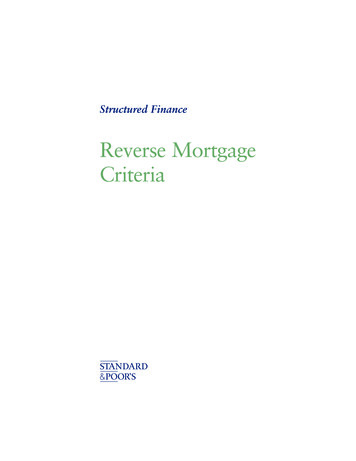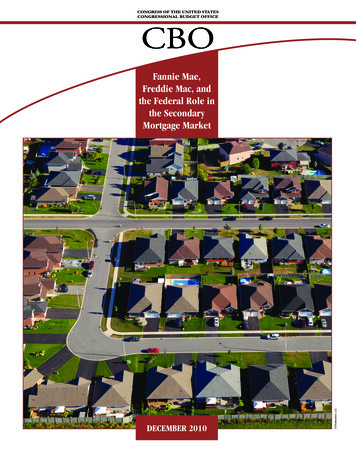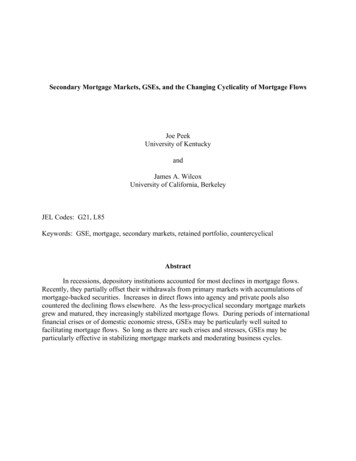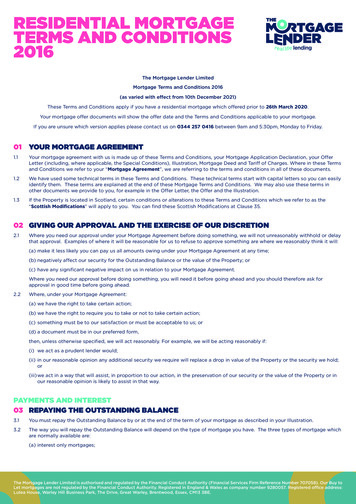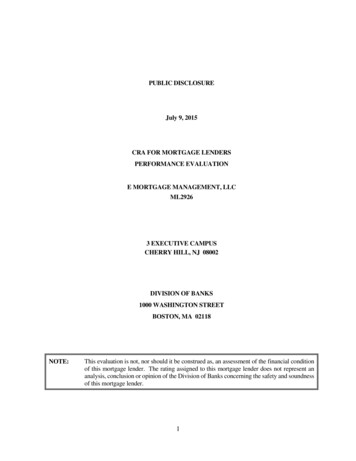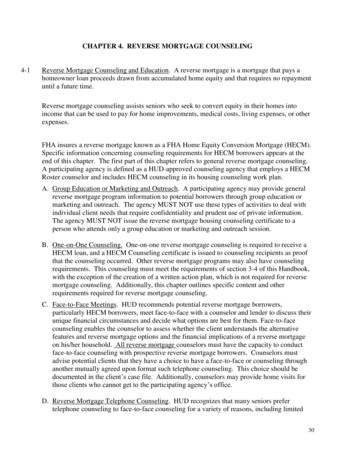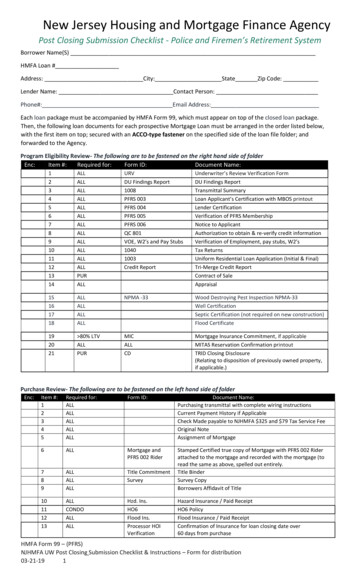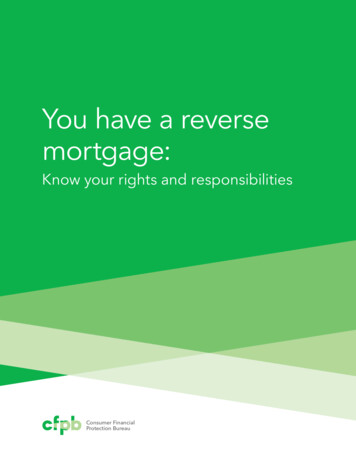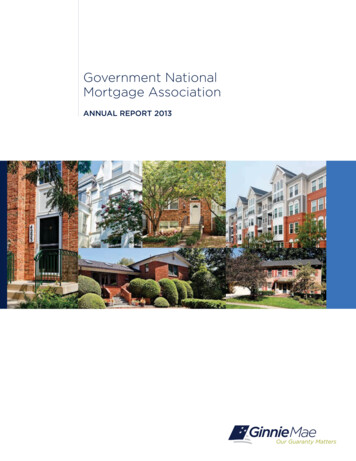
Transcription
Government NationalMortgage AssociationANNUAL REPORT 2013
Secretary’s MessageFor more than 45 years, Ginnie Mae has been leveraging the combined resources of the U.S. Government andthe private sector to infuse capital into the Nation’s housing finance market and assist millions of low-and moderateincome households to find an affordable place to live.Ginnie Mae’s strong foundation, based on sound financial discipline, has positioned the organization for long-termsuccess and growth and contributed to its status as a strong, successful, independently financed, wholly ownedcorporation of the U.S. Government. This enables Ginnie Mae, through its numerous programs, to support housingliquidity around the country at no cost and limited risk to taxpayers. Moreover, Ginnie Mae funds its programsprimarily through user fees and remained highly profitable, even during the recent financial crisis and its aftermath.Ginnie Mae relies on a clear and simple model that allows the Federal Government and the private sector to workcollaboratively in support of homeowners, renters, mortgage lenders, and investors. The sustainability of this modellends stability, consistency, and accountability to its mortgage-backed securities programs, which allow for flexibilityand adaptability in an ever-evolving housing market.As this market continues to stabilize and recover, Ginnie Mae is building for the future. By continuing to invest in itstechnology and infrastructure, augment its risk-management practices, and foster a stakeholder-centric organization,Ginnie Mae is solidifying its commitment to delivering top securitization capabilities and operational expertise thatattract global capital to America’s housing finance system.I commend Ginnie Mae on its continued success.Shaun DonovanOUR GUARANTY MATTERS1
December 6, 2013The Honorable Shaun DonovanSecretaryU.S. Department of Housing and Urban Development451 7th Street, SWWashington, DC 20410Dear Mr. Secretary:As the end of another year approaches, I am happy to report that Ginnie Mae’s foundation and business model remainstrong, sustainable, and profitable as we continue to build for the future.Ginnie Mae’s strong foundation is grounded in financial discipline, sound risk management processes and a growingteam of leading mortgage and capital markets professionals organized for long-term success and growth. Our continuedprofitability as a self-financed government corporation is a direct result of effective resource deployment, careful expensemanagement, and products that attract investment capital from all over the world.Our simple and unique business provides stability to the U.S. housing finance system in good times and bad. Ginnie Mae’sfull-faith-and-credit backing, combined with the flexibility of our mortgage securitization products, attracts a growingnumber of mortgage lenders to our programs. We require our lender partners to protect taxpayers from risk exposure byhaving skin in the game and retaining financial responsibility for the securities they issue.The results of our proven business model are clear. Ginnie Mae has profitably guaranteed 2.0 trillion in mortgagebacked securities since 2009, providing housing opportunities for 8.8 million households. During the past year alone, weguaranteed 460 billion in securities, translating to nearly 2.1 million homes across the country.We continue to make significant investment in our future by modernizing our technology and data infrastructure andproviding loan-level collateral data that our investor community has come to expect. Responding to investor needs is justone of the ways in which we are fostering a stakeholder-centric organization that balances the interests of borrowers andlenders and provides leadership on housing reform issues.In times like these it becomes increasingly clear that Ginnie Mae’s guaranty matters. I take tremendous pleasure inpresiding over such a dynamic organization that continues to successfully balance the relationship of the private marketwith the U.S. Government, delivering leading securitization capabilities and operational expertise in support of America’shousing finance system.Sincerely,Theodore W. Tozer. President2GINNIE MAE ANNUAL REPORT 2013
CONTENTS01 Ginnie Mae’s Foundation is Strong. 5Mission and Purpose. 5Today’s Ginnie Mae. 6Ginnie Mae’s History and Development of theMortgage-Backed Security. 6Supporting Mortgage Liquidity and Protectingthe Taxpayer. 7Ginnie Mae’s Risk Model. 8Ginnie Mae’s Products and Programs.10Prudent Use of the Strength of the Full Faith andCredit Guaranty.12Ensuring a Liquid Market.1302 Financial Highlights and Management’sDiscussion and Analysis.15Revenues.17Expenses.1903 Audit Report of Ginnie Mae’s FY 2013 andFY 2012 Financial Statements.25OUR GUARANTY MATTERS3
4GINNIE MAE ANNUAL REPORT 2013
01Ginnie Mae’sFoundation isStrongMission and PurposeThe Government National Mortgage Association’s (Ginnie Mae) mission andpurpose is to bring global capital into the housing finance system—a systemthat runs through the core of our Nation’s economy—while minimizing risk tothe taxpayer. The simple but strong business model that Ginnie Mae has builthighlights the power of the Federal Government and the private sector workingtogether. Through an efficient and low-cost securitization model, Ginnie Maeprovides liquidity and fulfills the needs and demands of various market segmentsby leveraging the full faith and credit of the United States to access global capital.Established by Congress in 1968 as a Government-owned corporation,Ginnie Mae’s statutory purpose is to ensure that adequate capital and liquidity areavailable to finance single family homes, multifamily housing, rental housing andhealthcare facilities throughout all market conditions. Ginnie Mae successfullyplayed a countercyclical role for housing finance in the secondary mortgagemarket during the worst economic crisis since the Great Depression. The recenthousing crisis demonstrated the critical importance of government-guaranteedsecurities as the private market retreated. Today, Ginnie Maeremains a self-financing, wholly-owned U.S. Governmentcorporation within the Department of Housing and UrbanThe strength, simplicity, and agility ofGinnie Mae’s unique mission and business Development.model serve to help maintaina well-functioning mortgage marketwhile minimizing taxpayer risk.Ginnie Mae does not originate mortgage loans, nor does itbuy or sell securities or loans for investment purposes. Rather,it guarantees investors the timely payment of principal andinterest on securities backed by loans insured or guaranteedby other Federal Government housing agencies. In doing so, Ginnie Mae standsin the fourth loss position behind three layers of risk absorption, includingborrowers’ equity, Federal Government loan-level mortgage guarantee programs,and the corporate resources of the lender that issues the mortgage-backed security(MBS). The strength, simplicity, and agility of Ginnie Mae’s unique mission andbusiness model serve to help maintain a well-functioning mortgage market whileminimizing taxpayer risk.OUR GUARANTY MATTERS5
Ginnie Mae reaffirmed its leadershipposition by sustaining its steady supportof the housing market, playing a vital rolein our Nation’s economic recovery.Ginnie Mae’s business model continues to attract bothinternational and domestic attention. This model hasprovided an uninterrupted, reliable investment vehicleacross the global markets for MBS investors who rely onGinnie Mae’s safety and soundness. Ginnie Mae is alsorecognized for its definitive presence and role within theNation’s housing market today and for the role it is ready toplay in the future.In Fiscal Year (FY) 2013, Ginnie Mae reaffirmed its leadershipposition by sustaining its steady support of the housingmarket, playing a vital role in our Nation’s economic recovery.This past year, Ginnie Mae also established market standardsfor securities’ transparency and disclosure, enhanced riskmanagement and technology, and extended organizationalcapabilities to meet the needs of the capital markets todayand for future success.Today’s Ginnie MaeAs the housing market begins to show signs of stabilization,Ginnie Mae’s contribution throughout the crisis standsout as a model for the secondary mortgage market and fornational housing policy. Ginnie Mae’s fundamental purposeto support affordable financing for housing in Americaby linking global capital markets to the Nation’s housingmarkets continues. The demand for its products and the needfor the efficient, low-cost securitization model it provides6GINNIE MAE ANNUAL REPORT 2013have increased. The number of lenders issuing Ginnie Maesecurities is growing. Ginnie Mae’s increased investment intechnology, infrastructure, and staffing expertise has ensuredthat the expanding needs of the market are met.Ginnie Mae’s History and Development ofthe Mortgage-Backed SecurityGinnie Mae’s origins stem from the Government’s effortsto help revitalize the U.S. housing market during the GreatDepression. The Federal National Mortgage Association(Fannie Mae) was chartered in 1938 to create a mortgagemarket by purchasing FHA-insured loans from lenders inorder to support the flow of credit and encourage lenders tomake mortgage loans.The Housing and Urban Development Act of 1968 splitFannie Mae into two separate corporations: (1) the currentFannie Mae, to purchase “conventional” (non-Governmentbacked) mortgages that conform to specific underwritingstandards; and (2) Ginnie Mae, to focus on creating anMBS market that provides a guaranty backed by the fullfaith and credit of the United States. The guaranty assuresinvestors they will receive timely payment of monthlyprincipal and interest (P&I) on MBS secured by pools ofloans guaranteed or insured by the Federal Government.This guaranty is invoked only in the rare occurrence whenan Issuer1 defaults on its obligation to make that timelymonthly payment of P&I.1 Ginnie Mae uses the term Issuer to refer to the lenders that issueor service securities in its program. Unlike the Government-sponsoredenterprises (GSEs), Issuers are legally responsible for paying thesecurity holders, administering the securities, and servicing themortgages.
The creation of Ginnie Mae eliminated the U.S. Treasury’sneed to provide funding for Federal Government loanprograms. Today, Ginnie Mae remains the primary financingmechanism for all Government-insured or Governmentguaranteed mortgages. Historically, mortgage rates andavailability of funds varied by region, and individualmortgages were rarely sold on the secondary market. Lendershad customarily retained their mortgage loans in portfolios,which limited the number of new loans that could beoriginated.In 1970, Ginnie Mae addressed these impediments to newloan origination by designing and pioneering the very firstMBS, which allowed for many loans to be pooled and usedas collateral in a security that could be sold in the secondarymarket. The explicit Government guaranty of the timelyreceipt of P&I on the behalf of the Issuers made thesesecurities especially attractive to investors. By channelinginvestment capital from global markets, Ginnie Mae MBSsupport housing finance and neighborhoods across theNation and infuse liquidity into the housing finance system.Supporting Mortgage Liquidity andProtecting the TaxpayerGinnie Mae only guarantees the performance of the Issuer.Ginnie Mae does not take credit or default risk on theunderlying loans. The U.S. agencies insuring or guaranteeingthe underlying mortgages include the Federal HousingAdministration (FHA), the Department of Housing andUrban Development’s (HUD) Office of Public and IndianHousing (PIH), the Department of Veterans Affairs’ (VA)Home Loan Program, and the Department of Agriculture’s(USDA) Rural Housing Service Single Family, Multifamily,and Community Facilities guaranteed loan programs (RuralDevelopment, or RD). Ginnie Mae remains a self-financing,wholly owned U.S. Government corporation within HUD.Issuers pool Government-backed mortgage loans, issuethe MBS, and service and manage the MBS portfolio andthe underlying loans. Ginnie Mae, in turn, guarantees thetimely payment of principal and interest to the investors.In exchange for this guaranty, Issuers pay Ginnie Mae a feefrom the spread between the interest rate paid by mortgageborrowers and the interest rate paid to MBS investors.OUR GUARANTY MATTERS7
Issuers in the Ginnie Mae program are qualified institutionsthat are individually approved and closely monitoredby Ginnie Mae’s detailed risk management framework.Ginnie Mae Issuers are diverse in size and geography andinclude mortgage companies, commercial banks, thrifts,credit unions, and state housing finance agencies (HFA)(see Figure 1).Investors seek the Ginnie Mae guaranty, coupled withan expected rate of return higher than U.S. Governmentsecurities. The Ginnie Mae MBS is highly liquid and attractiveto domestic and foreign investors. This liquidity is passedon to lenders who can use the proceeds from new securityissuances to make new mortgage loans.Active investor interest ensures the capital flow to Ginnie Maeguaranteed securities (as depicted in Figure 2) which helpsto lower financing costs, which in turn supports accessibleand affordable rental housing and homeownership. Becausethe securities are backed by the full faith and credit of theU.S. Government, the investor market is larger and broader,and financing is available at lower mortgage interest rates,which benefits borrowers and renters.FIGURE 1: GINNIE MAE ISSUERS BYINSTITUTION TYPE as of September 30, 2013n 69% Mortgage Banksn 5% Savings and Loansn 15% Commercial Banksn 3% Mutual Savings Banksn 3% Credit Unionsn 5% Others8GINNIE MAE ANNUAL REPORT 2013Ginnie Mae’s Risk ModelGinnie Mae is a mono-line business that insures only Issuerperformance. There are three levels of protection that mustbe exhausted before the Ginnie Mae guaranty is at risk:homeowner equity, the insurance provided by the FederalGovernment agency that insured the loans, and the corporateresources of the lender that issued the security. Ginnie Maeis in the fourth and final loss position (Figure 3). An Issuermust exhaust its corporate resources—usually throughbankruptcy—before Ginnie Mae will take on the Issuer’srole and pay on its guaranty to investors. By insuring only theperformance of Issuers in their servicing responsibilities andrequiring them to make principal and interest paymentsto investors until they can no longer do so, Ginnie Maesignificantly reduces taxpayer exposure to risk.Even if an Issuer fails to meet its obligations, Ginnie Maedoes not necessarily suffer a loss. Instead, it acquirescontrol of the Issuer’s mortgage servicing rights and placesthe portfolio with a financially sound Issuer. It is throughinvestors’ confidence in this sustainable business model thatGinnie Mae ensures that capital continues to flow to theNation’s housing finance system.The credit exposure of Ginnie Mae is limited to counterpartyrisk because Ginnie Mae guarantees that an Issuer willmeet its obligations. Ginnie Mae manages this risk through
FIGURE 2: CAPITAL FLOW OF GINNIE MAE GUARANTY SECURITIESGinnie Mae’s Risk ModelLENDERSOriginate Loans underGuidelines ofFederal Credit ProgramsINVESTORSPurchase Securities andReceive Monthly Passthroughof Principal and Interestfrom BorrowersFHA, VA, RURALDEVELOPMENT, OR PIHInsure or Guarantee LoansISSUERS(Often the Lenders orTheir Affiliates) Pool Loansand Create Mortgagebacked SecuritiesGINNIE MAEGuarantees InvestorsTimely Paymentof Principal and Intereston SecuritiesFIGURE 3: PROTECTING THE GINNIE MAE GUARANTYGinnie MaeLAST LOSSLAST LOSSCorporateResourcesof Issuer/ServicerFannie/FreddiePrivate CreditEnhancement GovernmentAgencyCreditEnhancement FIRST LOSSHomeownerEquityPrivate MortgageInsurance FIRST LOSSHomeownerEquityRELATIVE LOSS POSITIONRELATIVE LOSS POSITION*VA covers the first 25% of credit loss, USDA-RHS covers the first 90%, and FHA covers 100%. Coverage of foreclosure expenses varies by agency; uncoveredexpenses can be substantial.**Private Mortgage Insurance (PMI) is only required for loans with 80% LTV; loans with 80% LTV have no PMI.***Private Credit Enhancement is the result of a recent FHFA mandate on Fannie Mae and Freddie Mac requiring them to establish risk-share instruments withprivate enterprises or investors.OUR GUARANTY MATTERS9
its comprehensive Issuer approval process and ongoingmonitoring procedures, both of which are a part of a multilayer risk management framework.This is the result of investors’ growing preference for multiIssuer pools, as well as increased appetite for larger poolswith diverse collateral characteristics.Ginnie Mae’s Products and ProgramsThe Ginnie Mae MBS also serve as the underlyingcollateral for multiclass products, such as Real EstateMortgage Investment Conduits (REMICs), CallableTrusts, Platinum Securities, and Stripped Mortgage-BackedSecurities (SMBS). Ginnie Mae also guarantees the timelypayment of principal and interest of these products. Thesestructured transactions allow the private sector to combineand restructure cash flows from Ginnie Mae MBS intosecurities that meet unique investor requirements for yield,maturity, and call-option features.Ginnie Mae offers reliable solutions that meet the needs ofa broad constituent base of borrowers, lenders and investorsand provides sufficient flexibility to respond to marketchanges. At the core of its business model and productofferings is the simple pass-through security, which comes inthe form of two product structures—Ginnie Mae I MBS andGinnie Mae II MBS. Characteristics of each are summarizedin the following table.The Ginnie Mae I Single Issuer MBS is the foundationof its MBS program. In recent years, however, theGinnie Mae II MBS has generated increased demand andsurpassed the Ginnie Mae I MBS in terms of issuancevolume. In FY 2013, the Ginnie Mae II program accountedfor approximately 82 percent of Ginnie Mae’s MBS issuance.Multiclass products are structured for offering in thepublic markets by “sponsors.” These sponsors are approvedGinnie Mae securities dealers in the REMIC program, anddepositors in the platinum program, who have wide access toglobal investors. By managing the ongoing relationship withGINNIE MAE I MBSGINNIE MAE II MBSSingle-issuer poolsSingle- or multiple-issuer poolsNote rates on underlying mortgages are fixed andall the sameMultiple note rates on underlying mortgages—limited to a range of 50 basis points (0.25 to 0.75above the pass-through interest rate)Acceptable collateral:Acceptable collateral: To Be Announced (TBA) eligible: Single FamilyLevel Payment Mortgages TBA eligible: Single Family Level PaymentMortgages, including up to 10 percent BuydownMortgages Non-TBA eligible: Buydown Mortgages,Graduated Payment Mortgages, Growing EquityMortgages, Serial Notes, Manufactured HomeLoans, Project Loans, Construction LoansTiming of payments: 15th of the month Non-TBA eligible: Adjustable-rate Mortgages,Graduated Payment Mortgages, Growing EquityMortgages, Serial Notes, Manufactured HomeLoans, Home Equity Conversion Mortgage(HECM) LoansTiming of payments: 20th of the monthLarger pool sizeMore demographically and geographically diverseCustomizable pools10GINNIE MAE ANNUAL REPORT 2013
REMICsInvestment vehiclesreallocate pass-throughcash flows fromunderlying mortgageobligations into aseries of differentbond classes, knownas tranches, which varybased on term andprepayment risk.CALLABLE TRUSTSInvestors can redeemor call a securityprior to its maturitydate under certainconditions to hedgeagainst fluctuatinginterest rateenvironments.investment banks and institutional investors, Ginnie Maesupports multiple products that meet the needs of globalcapital market participants and attract financing to the U.S.housing market.This wide range of Ginnie Mae security products financesthe diverse single family and multifamily lending initiativesprovided by the Government’s housing agencies. ThoseGovernment-insured and guaranteed lending programsalign with Ginnie Mae’s four MBS programs. These programsare designed to serve a variety of loan financing needs anddifferent Issuer origination capabilities. All loans in each ofthese programs are insured or otherwise guaranteed by theGovernment, which minimizes risk to Ginnie Mae.Ginnie Mae supports multiple productsthat meet the needs of global capitalmarket participants and attract financingto the U.S. housing market.Single Family Program: The majority of Ginnie Mae securitiesare backed by single family mortgages predominantlyoriginated through FHA and VA loan insurance programs(61.9 percent and 32.9 percent, respectively). In FY 2013,96.7 percent of FHA fixed-rate single family loans and98.0 percent of VA fixed-rate single family loans were placedinto Ginnie Mae pools. As of the end of FY 2013, investorsheld 1.3 trillion in outstanding single family Ginnie MaePLATINUMSECURITIESSMBSInvestors can holdmultiple pools of MBSto combine them intoa single Ginnie MaePlatinum Certificate.Custom-designedsecurities that redirectMBS principal and/orinterest cash flows tomeet investors’ specificobjectives. Ginnie Maeguarantees the timelypayment of principaland interest on eachclass of SMBS.MBS. The Single Family Program supports purchasemortgages, loans that are modified to support loss mitigationprograms, as well as mortgage refinancing.Within the Single Family MBS Program, the TargetedLending Initiative (TLI) provides incentives for lenders toincrease loan volumes in traditionally underserved areas.Established in 1996, the TLI program offers discountsranging from one to three basis points on Ginnie Mae’ssix-basis-point guaranty fee, depending on the percentageof TLI-eligible loans within the pool or loan package. Thereduced fee motivates lenders to originate loans in thesedistressed areas.Multifamily Program: Ginnie Mae’s Multifamily MBSProgram enables lenders to reduce mortgage interest ratespaid by property owners and developers of apartmentbuildings, hospitals, nursing homes, assisted livingfacilities, and other types of housing. These lower interestrates provide the necessary incentive for many developersto construct or substantially rehabilitate new projects.The importance of multifamily financing is growing as thepopulation ages, facilities need renovation, and the demandfor memory care services increases. Tailored for manyproperty types and financing scenarios, Ginnie Mae’sMultifamily MBS Program reaches diverse segments ofthe U.S. rental housing market and finances projects thatstabilize local economies and bring jobs to communitiesacross the country. The sophisticated and flexible structureOUR GUARANTY MATTERS11
of the program provides Ginnie Mae with a competitiveadvantage over other multifamily financing offerings in theindustry. This advantage is due to four key characteristicstypically attributed to government loan programs: lowerinterest rates on loans; higher loan-to-value ratio forborrowers; all-in-one construction to permanent loanorigination; and an advantageous capital source for healthcare properties, including nursing homes and hospitals.In FY 2013, Ginnie Mae’s Multifamily MBS portfolioincreased to 79.8 billion, compared to 67.4 billion inFY 2012, helping to finance 1,854 apartment buildingloans, 46 hospital loans, and 690 nursing home loans.Home Equity Conversion Mortgage (HECM) MBS (HMBS)Program: Ginnie Mae’s HECM securities program providescapital and liquidity for FHA-insured reverse mortgages.HECM loans can be pooled into HMBS within theGinnie Mae II MBS program. They also can serve as collateralfor REMICs backed by HMBS (H-REMICs). Ginnie Maehas been a pioneer in the development of a liquid securitiesmarket for reverse mortgages, providing senior citizens withaccess to their home equity during challenging economictimes. In FY 2013, Ginnie Mae’s HMBS portfolio reached 44.6 billion, compared to 36.9 billion in FY 2012.12GINNIE MAE ANNUAL REPORT 2013Ginnie Mae has been a pioneer in thedevelopment of a liquid securities marketfor reverse mortgages, providing seniorcitizens with access to their home equityduring challenging economic times.Manufactured Housing (MH) Program: Ginnie Mae’s MHprogram provides financing for and allows the issuanceof pools of loans insured by FHA’s Title I ManufacturedHome Loan program for manufactured home loans that donot include land as collateral. This program went throughsignificant changes in support of the Housing and EconomicRecovery Act of 2008 (HERA).Prudent Use of the Strength of the FullFaith and Credit GuarantyThe full faith and credit guaranty separates Ginnie Maefrom all other MBS guarantors, including Fannie Mae andFreddie Mac. As federally chartered secondary marketparticipants, these Government-sponsored enterprises(GSEs) share many similarities with Ginnie Mae. Theseorganizations each provide liquidity in the secondarymortgage market, support housing finance opportunities,
and guarantee MBS by ensuring the timely paymentof principal and interest to investors. Their structureand business models, however, differ in a number ofways, including most notably their guaranty of the loansunderlying the MBS.The key differences between Ginnie Mae and the GSEs aresummarized in the table below.Ensuring a Liquid MarketThe recovery of the housing market depends on a reliablesupply of liquidity that only a strong capital market canprovide. The consistent performance of Ginnie Mae’s MBSproducts has been essential to providing this liquidity. Issuersknow that Ginnie Mae securities provide attractive pricingand are an important asset class for many investors. Thefavorable pricing on securities, enabled by the Ginnie Maeguaranty, is ultimately passed on to many homeownersand renters in the form of lower interest rates and moreattractive leasing terms. In addition, these securities providethe financing necessary for all Federal Government loanguarantee programs that support safe and affordable housing.Ginnie Mae’s creation of pass-through securities also led tothe establishment of the “To Be Announced” (TBA) market,a critical feature of the secondary mortgage market allowingfor future lending commitments and valuation. Investors inTBA securities know that the terms and conditions of thesecurity are consistent and the underlying mortgage loansare comprised of relatively homogeneous collateral. Thisinnovative process enables lenders to lock in a rate for themortgages before closing, which facilitates the availabilityGINNIE MAEGovernanceGovernmentGuarantyWholly owned Government corporationGSEsUnder Government conservatorship sinceSeptember 2008 but remain publicly tradedcompanies (not on NYSE)Explicit guaranty to investorsImplicit guaranty to investorsBusinessActivitiesDoes not purchase loans, nor does it buy, sell,or issue securities as part of its regular courseof business, but approves private lendinginstitutions to issue MBS for which Ginnie Maeprovides the guaranty.Purchase loans, and they buy, sell, and issuesecurities.Rates and TermsTrade at a higher price than comparable GSEMBS, thus providing a lower interest rate toborrowersTrade at lower prices relative to Ginnie MaeMBSFunctionsGuaranty and bond administration of MBS OnlyLoan-level guaranty and bond administration ofMBS; and management of investment portfolioof whole loans and MBSRiskLimited risk to Ginnie Mae. Issuer/Servicer Risk.Issuers must have capital to advance paymentsof principal and interest to investors when aloan defaults. Government agencies insurance(e.g., FHA, VA, RD, PIH) repays Issuers forprincipal (not Ginnie Mae). Also, Issuers areresponsible for unreimbursed credit losses forthe securities they issue.Significant risk to the GSEs. Borrower CreditRisk, Interest Rate Risk, and Servicer Risk. TheseGSEs guarantee full repayment of principalto investors when a loan defaults. Also, theseGSEs are responsible for the risk of loss on theirsecurities.Government-backed loans (FHA, VA, RD, PIH)Conventional LoansEligible CollateralOUR GUARANTY MATTERS13
FIGURE 4: MARKET SHARE OF GINNIE MAE AND GSE SECURITIESCalendar Years 2009 through 201321000800600400200020092010201120122013n Ginnie Mae 446.2 383.6 301.7 394.4 312.5n Fannie Mae 807.9 629.7 551.0 827.9 622.3n Freddie Mac 470.8 387.0 301.8 439.7 357.3n Non-agency 60.4 59.9 27.6 13.1 25.4MBS ISSUANCE( BILLIONS)2 Source: Inside MBS & ABS. MBS issuance figures based on the 12 months of the calendar year for 2009 through 2012, andfor the first 9 months of calendar year 2013.of affordable mortgages to millions of prospectivehomeowners. Although established many years ago, asignificant portion of the volume of MBS traded in themarket today continues to be in the form of TBA securities,which are contracts for the purchase or sale of a type of MBSsecurity that will be delivered at a future agreed-upon date.Though the specific loans, pool numbers or the number ofpools that will be delivered to fulfill the trade obligationor
As the housing market begins to show signs of stabilization, Ginnie Mae's contribution throughout the crisis stands out as a model for the secondary mortgage market and for national housing policy. Ginnie Mae's fundamental purpose to support affordable financing for housing in America by linking global capital markets to the Nation's housing

